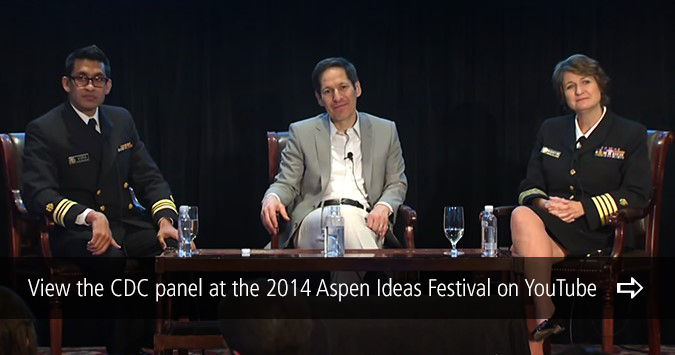You are here
Boots On The Ground: CDC's Elite Disease Detectives
In a world with increased international travel and emerging global health threats such as Ebola, MERS-CoV and antibiotic resistance, the keys to keeping people safe are prevention and protection. An expert panel discussion, Boots on The Ground: CDC’s Elite Disease Detectives, at the 2014 Aspen Ideas Festival explored the many ways in which CDC and its Epidemic Intelligence Service (EIS) officers, also known as disease detectives, contribute to global health security by managing outbreaks around the world.
For the conversation, CDC Director Dr. Tom Frieden was joined by two of CDC’s EIS officers, Dr. Neil Vora and Dr. Jennifer McQuiston, to discuss the CDC’s role in addressing emerging global health threats. The trio shared first-hand accounts of the epidemiological sleuth work that goes into tracing outbreaks and protecting the public.
For more than 60 years, the EIS program has existed as a two-year post-doctoral training opportunity for health professionals to learn and practice applied epidemiology within the United States and internationally. Frieden hopes that the CDC model can one day extend beyond U.S. borders.
“Years ago, the U.S. ambassador to Africa said to me that the CDC is the 9-1-1 for the world,” Frieden said. “The more I thought about it, the more I realized that really what we'd like is to make sure that every single country has its own public health 9-1-1.”
According to Frieden, the three biggest threats in the infectious disease world are emerging infections, antibiotic resistant infections, and intentionally-created infections. CDC has a major role in helping lead response efforts on these types of threats around the world. Most recently, Frieden has announced plans to send 50 additional CDC staff members, including EIS officers, to the Ebola outbreak in West Africa where they will bolster disease control and containment efforts.
The stories told by EIS officers Vora and McQuiston quickly transport the audience around the world—from a rabies outbreak in Maryland to the discovery of a new orthopoxvirus in the Republic of Georgia. McQuiston recounted being flown to New York City’s ground zero just after the 9/11 terrorist attacks to investigate the potential of bioterror agents.
"We have a group of people ready to respond at any moment, at any time, and we can mobilize dozens of people to go and work on an emergency.” McQuiston said. “That’s the real value of EIS.”
One common thread discussed by all of the panelists was the agency’s critical role in the research, surveillance and investigation of outbreaks far and near.
“Some people might wonder why CDC would take an interest in activity taking place on the other side of the planet,” Vora said. “You have to keep in mind that we live in an interconnected world, so a health threat anywhere is a health threat everywhere. By remaining vigilant for these types of risk factors, we can better prepare ourselves for the next outbreak.”
